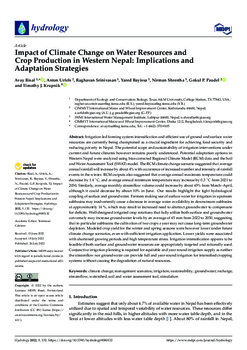Mostrar el registro sencillo del ítem
Impact of climate change on water resources and crop production in Western Nepal: Implications and adaptation strategies
| Creador: | Risal, A. |
| Creador: | Urfels, A. |
| Creador: | Srinivasan, R. |
| Creador: | Bayissa, Y. |
| Creador: | Shrestha, N. |
| Creador: | Paudel, G.P. |
| Creador: | Krupnik, T.J. |
| Año: | 2022 |
| URI: | https://hdl.handle.net/10883/22136 |
| Lenguaje: | English |
| Editor: | MDPI |
| Copyright: | CIMMYT manages Intellectual Assets as International Public Goods. The user is free to download, print, store and share this work. In case you want to translate or create any other derivative work and share or distribute such translation/derivative work, please contact CIMMYT-Knowledge-Center@cgiar.org indicating the work you want to use and the kind of use you intend; CIMMYT will contact you with the suitable license for that purpose |
| Tipo: | Article |
| País de enfoque: | Nepal |
| Lugar de publicación: | Basel (Switzerland) |
| Número: | 8 |
| Volumen: | 9 |
| DOI: | 10.3390/hydrology9080132 |
| Palabras Claves: | Management Scenarios |
| Palabras Claves: | Streamflow |
| Palabras Claves: | Assessment Tools |
| Descripción: | Irrigation-led farming system intensification and efficient use of ground and surface water resources are currently being championed as a crucial ingredient for achieving food security and reducing poverty in Nepal. The potential scope and sustainability of irrigation interventions under current and future climates however remains poorly understood. Potential adaptation options in Western Nepal were analyzed using bias-corrected Regional Climate Model (RCM) data and the Soil and Water Assessment Tool (SWAT) model. The RCM climate change scenario suggested that average annual rainfall will increase by about 4% with occurrence of increased number and intensity of rainfall events in the winter. RCM outputs also suggested that average annual maximum temperature could decrease by 1.4 °C, and average annual minimum temperature may increase by 0.3 °C from 2021 to 2050. Similarly, average monthly streamflow volume could increase by about 65% from March–April, although it could decrease by about 10% in June. Our results highlight the tight hydrological coupling of surface and groundwater. Farmers making use of surface water for irrigation in upstream subbasins may inadvertently cause a decrease in average water availability in downstream subbasins at approximately 14%, which may result in increased need to abstract groundwater to compensate for deficits. Well-designed irrigated crop rotations that fully utilize both surface and groundwater conversely may increase groundwater levels by an average of 45 mm from 2022 to 2050, suggesting that in particular subbasins the cultivation of two crops a year may not cause long-term groundwater depletion. Modeled crop yield for the winter and spring seasons were however lower under future climate change scenarios, even with sufficient irrigation application. Lower yields were associated with shortened growing periods and high temperature stress. Irrigation intensification appears to be feasible if both surface and groundwater resources are appropriately targeted and rationally used. Conjunctive irrigation planning is required for equitable and year-round irrigation supply as neither the streamflow nor groundwater can provide full and year-round irrigation for intensified cropping systems without causing the degradation of natural resources. |
| Agrovoc: | CLIMATE CHANGE |
| Agrovoc: | IRRIGATION |
| Agrovoc: | SUSTAINABILITY |
| Agrovoc: | GROUNDWATER RECHARGE |
| Agrovoc: | WATERSHEDS |
| Agrovoc: | SIMULATION |
| ISSN: | 2306-5338 |
| Revista: | Hydrology |
| Número de artículo: | 132 |
| Área de impacto CGIAR: | Nutrition, health & food security |
| Iniciativa CGIAR: | Transforming Agrifood Systems in South Asia |
| Área de acción CGIAR: | Resilient Agrifood Systems |
| Donante o financiador: | United States Agency for International Development (USAID) |
| Donante o financiador: | Bill & Melinda Gates Foundation (BMGF) |
| Identificador CGSpace: | https://hdl.handle.net/10568/126440 |
Ficheros en el ítem
Este ítem aparece en la(s) siguiente(s) colección(ones)
-
Sustainable Intensification
Sustainable intensification agriculture including topics on cropping systems, agronomy, soil, mechanization, precision agriculture, etc.

